
Guests
- Koichi Nakanoprofessor at Sophia University in Tokyo and director of the Institute of Global Concern at the university.
Democracy Now! is broadcasting from Tokyo, Japan, today in the first of three special broadcasts. At a critical time for Japan and the region, we begin our coverage looking at the country’s rightward political shift under Prime Minister Shinzo Abe, who was re-elected just over a year ago. As head of the Liberal Democratic Party, Abe is known as a conservative hawk who has pushed nationalistic and pro-nuclear policies. In December, he visited the controversial Yasukuni war shrine, which honors Japanese soldiers who died in battle, including several war criminals who were tried by the International Military Tribunal after World War II. The visit sparked outrage from China and South Korea, who consider the shrine a symbol of Japanese militarism and its refusal to atone for atrocities committed in the first half of the 20th century. We speak about Japan’s increasingly pro-nuclear, nationalistic stance with Koichi Nakano, professor at Sophia University in Tokyo and director of the Institute of Global Concern.
Transcript
AMY GOODMAN: We are on the road in Tokyo, Japan, for the first of three special broadcasts here. We’re here at a critical time for Japan and the region. Later in the show we’ll look at the crisis in Japan following the meltdown at the Fukushima nuclear plant that occurred nearly three years ago. Our visit to Japan comes less than a month after thousands of people rallied on the Japanese island of Okinawa to protest plans to build a new U.S. Marine base. Meanwhile, protests continue here in Japan over the Trans-Pacific Partnership. The TPP would establish a free trade zone stretching from the United States to Chile to Japan, encompassing nearly 40 percent of the global economy.
We’ll look at Okinawa and the TPP later in the week, but we begin today’s show looking at the rightward shift in Japan under Prime Minister Shinzo Abe, who was re-elected just over a year ago. Abe heads the country’s Liberal Democratic Party, is known as a conservative hawk who has pushed nationalistic and pro-nuclear policies. In December, he visited the controversial Yasukuni war shrine, which honors Japanese soldiers who died in battle, including several war criminals who were tried by the International Military Tribunal after World War II. The visit sparked outrage from China and South Korea, who consider the shrine a symbol of Japanese militarism and its refusal to atone for atrocities committed in China and Korea in the first half of the 20th century.
For more, I’m joined in our Tokyo studio by Koichi Nakano, professor at Sophia University here in Tokyo and director of the Institute of Global Concern at the university.
We welcome you, Professor, to Democracy Now!
KOICHI NAKANO: Thank you.
AMY GOODMAN: For a global audience, explain Japan’s politics today.
KOICHI NAKANO: Well, I think it’s fair to say that since Abe Shinzo came back to power in December 2012, there has been a rightward shift that resumed in politics, both in terms of economic reforms, but also in terms of increased attention to foreign and security policy, including the possible revision of the Constitution.
AMY GOODMAN: Explain this revision of the Constitution.
KOICHI NAKANO: Well, the Japanese post-war Constitution was instituted during the occupation period by the United States. And it’s particularly—
AMY GOODMAN: This is after World War II.
KOICHI NAKANO: That’s right. And—
AMY GOODMAN: After the U.S. dropped the atomic bombs on Hiroshima and Nagasaki.
KOICHI NAKANO: That’s right. And because of the military’s past that caused a great deal of damage to the region and beyond, there was a great deal of efforts to democratize and demilitarize Japan with the new Constitution after the Second World War. And it’s particularly famous for the Article 9, that renounces war and war potential as a country.
AMY GOODMAN: The U.S. said they couldn’t have a military.
KOICHI NAKANO: That’s right.
AMY GOODMAN: But they, in fact, have developed one—
KOICHI NAKANO: Yes.
AMY GOODMAN: —under a different name.
KOICHI NAKANO: Right. It’s called a self-defense force. And it has big capacity to defend the country. But there are still constitutional bans on Japan dispatching troops abroad, for example.
AMY GOODMAN: I wanted to go to the Japanese prime minister, Shinzo Abe, or Abe Shinzo—Abe is the last name, Shinzo his first—
KOICHI NAKANO: That’s right, yeah.
AMY GOODMAN: —but in Japanese you say the first name—
KOICHI NAKANO: Right.
AMY GOODMAN: —and last name first. So let’s go to Prime Minister Shinzo Abe after he visited the Yasukuni war shrine.
PRIME MINISTER SHINZO ABE: [translated] I showed my respects to the war dead, who sacrificed their precious lives for Japan, and I also prayed for their souls to rest in peace. I also prayed for the resting of the souls of all the people whose lives were taken by war. Additionally, I vowed for a renunciation of war, and I was emboldened to create an era where people’s lives would not be engulfed in pain by the misery of war.
AMY GOODMAN: And now let’s go to the response of China and South Korea. Both condemn Prime Minister Abe’s visit to this shrine. This is a spokesperson from the Chinese Foreign Ministry.
QIN GANG: [translated] It is a double-faced act that the Japanese leader made such remarks. He called black white and confused the public opinion. Some Japanese politicians, on one hand, keep talking about democracy, freedom and peace; on the other hand, promote militarism, beautify Japan’s foreign aggression and history of colonization. This is actually a blasphemy against democracy, freedom and peace. Abe’s visit to the Yasukuni Shrine jeopardized the political foundation of the China-Japan relationship and created new obstacles for improvement and development of bilateral ties. Japan will face all the consequences.
AMY GOODMAN: Professor Koichi Nakano, can you explain the significance? Some have compared it to when President Reagan visited the Bitburg cemetery with the German SS officers buried there.
KOICHI NAKANO: Right. Well, the Yasukuni war shrine is particularly notorious for enshrining 14 Class A war criminals, who are—
AMY GOODMAN: Class A war criminals.
KOICHI NAKANO: Right.
AMY GOODMAN: Who are they?
KOICHI NAKANO: Class A war criminals are basically wartime leaders of Japan, including Prime Minister Tojo, who attacked Pearl Harbor when he was prime minister. And the Chinese government, after, in the post-war period, made peace with Japan with the understanding that the Japanese people were also victims of wartime leaders who misled the country. And so, for the Chinese, the idea that the current prime minister visits the Yasukuni Shrine, where those war criminals are enshrined, is basically to say that Japan bears no responsibility for the wartime atrocities.
AMY GOODMAN: So why did he do it? Other prime ministers have not.
KOICHI NAKANO: Well, actually, there have been other prime ministers who have done that in the past, and—but it has become a taboo issue from 1985, in particular, when the Chinese government started to criticize very openly the visits by the prime minister. But before Abe in last December, Koizumi, too, while he was prime minister between 2001 and 2006, repeatedly visited the Yasukuni Shrine. And during that time period, the bilateral relationship between Japan and China were completely frozen.
AMY GOODMAN: I also want to ask about Japan’s state—the issue of Japan’s state secrets, recently enacted state secrets law. In November, the U.S. ambassador to Japan, now Caroline Kennedy, endorsed the law, saying, quote, “We support the evolution of Japan’s security policies, as they create a new national security strategy, establish a National Security Council, and take steps to protect national security secrets.”
KOICHI NAKANO: Right. The pressure coming from the U.S. has been going on for some time, and at the very latest, I think, already from 2009. And so, the bill of state secrecy has been in the pipeline for some time. And Abe, this time, seizing the opportunity by securing the majority in both houses of the Parliament, went ahead, in combination with another bill, as you just mentioned, that set up the Japanese version of the National Security Council.
AMY GOODMAN: And talk about state secrets. What are these state secrets?
KOICHI NAKANO: Well, it’s very poorly defined. It, of course, concerns primarily security issues and anti-terrorist measures. But in the parliamentary exchange, it became increasingly clear that the interpretation of what actually constitutes state secret could be very arbitrary and rather freely defined by government leaders. And, for example, anti-nuclear citizen movements can come under surveillance without their knowledge, and arrests can be made if it turns out that they obtain some information that they didn’t even know constituted state secrets.
AMY GOODMAN: You talk about a Japanese shock doctrine.
KOICHI NAKANO: Right. The state secrecy law that was passed in December last year, just a month ago, basically two years after the big earthquake and tsunami and the nuclear power accident, that still continues to literally kind of shake Japan, and in the climate of anxiety and insecurity, the government basically is pushing in the classic sort of Naomi Klein kind of way of shock doctrine. And for the Japanese, it is particularly worrisome because it reminds us of what happened before the Second World War, actually, when Tokyo was destroyed by a huge earthquake in 1923. And the peace preservation law that eventually led to the birth of state secret police and the brutality of the military regime was also enacted two years right after the big earthquake that destroyed Tokyo back in the 1920s. So, the parallel is quite spooky.
AMY GOODMAN: And the parallel now with Fukushima, what it would mean in a cover-up of what’s been happening? And we’re not talking about the past now—
KOICHI NAKANO: Exactly.
AMY GOODMAN: —though it’s almost three years ago.
KOICHI NAKANO: Exactly.
AMY GOODMAN: Because this is continuing to unfold.
KOICHI NAKANO: Exactly. The continuous contamination of water, of ocean, of the soil, and the continuous danger with the spent fuels in the nuclear reactors in Fukushima—I think there are lots of concerns, and citizens are trying to know the truth. But I think the state secrecy law is potentially going to make it easier for the government to cover up information.
AMY GOODMAN: Well, we’re going to continue to follow the politics of Japan and its relationship to the United States, as well as other countries around the world, in the coming days. And in our next segment, we’re going to look at Fukushima, what it has meant. We’ll be joined by David McNeill, who is co-author of Strong in the Rain. And then we’ll be talking with the Japanese filmmaker of a new film called Nuclear Nation. Koichi Nakano, I want to thank you very much for joining us, professor at Sophia University here in Tokyo, director of the Institute of Global Concern at the university. This is Democracy Now!, democracynow.org, The War and Peace Report. We’ll be back in a minute.

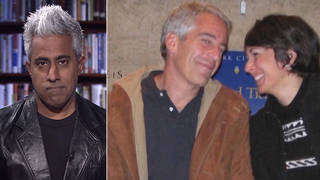
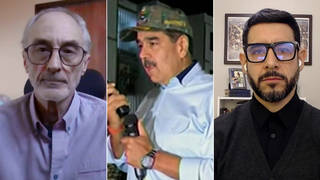
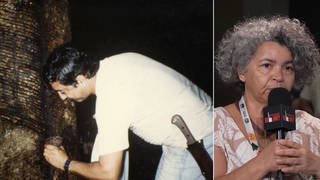
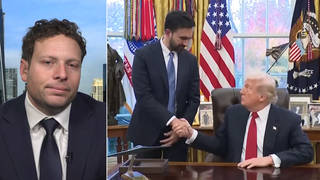





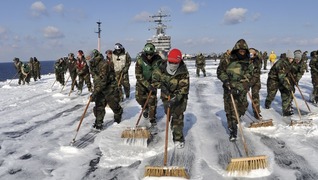
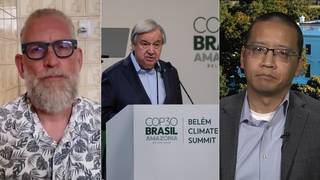
Media Options